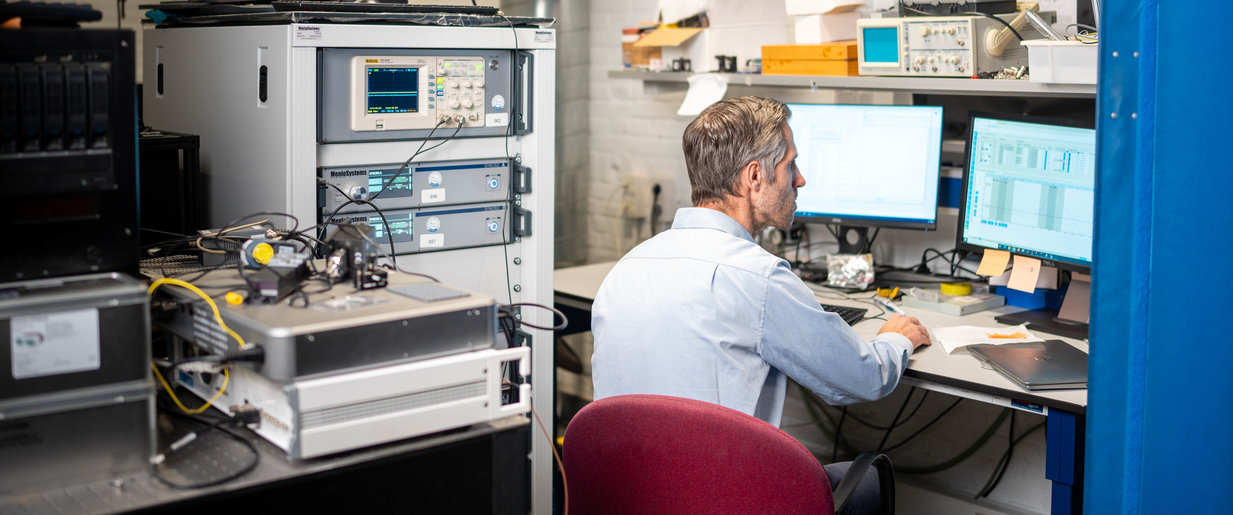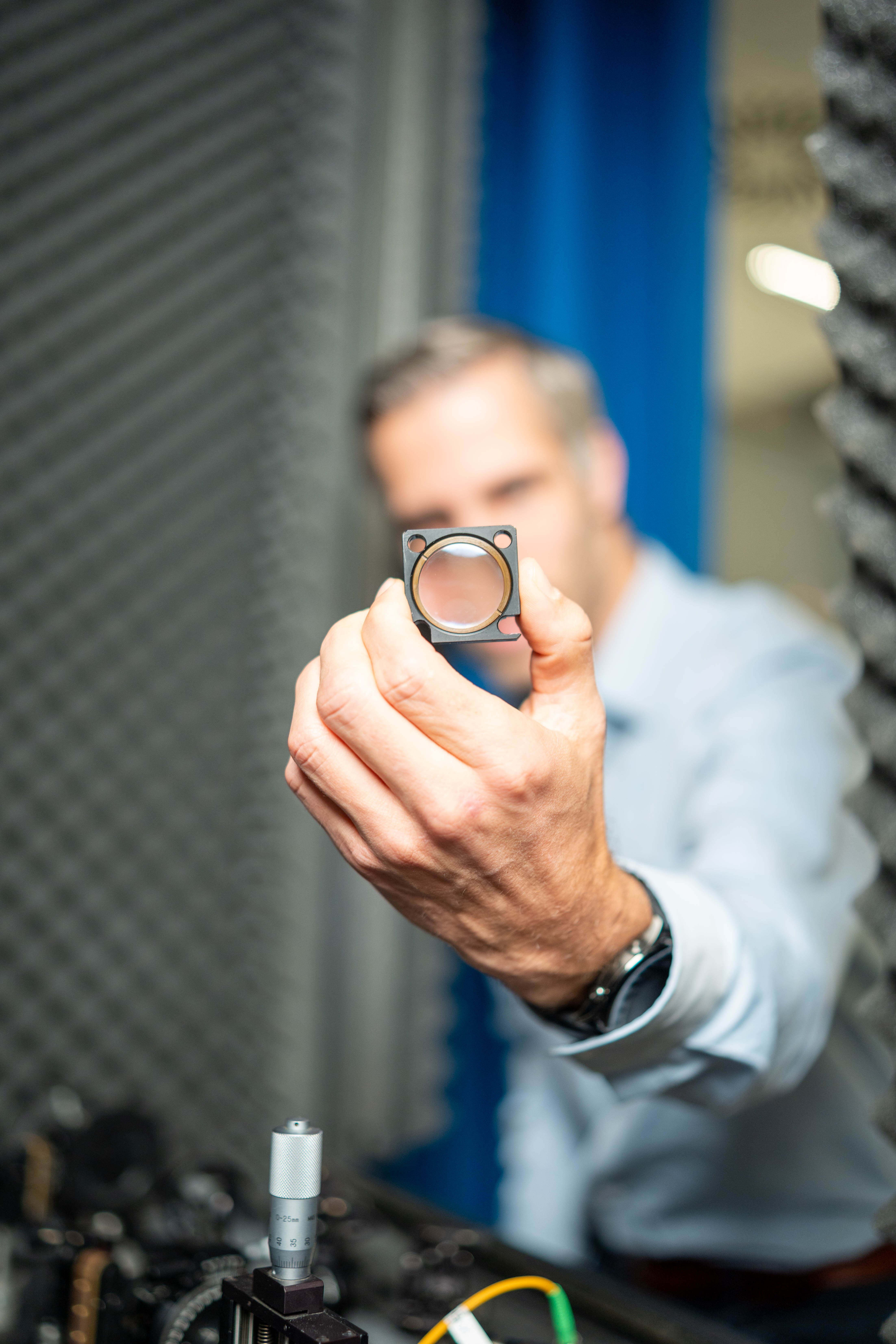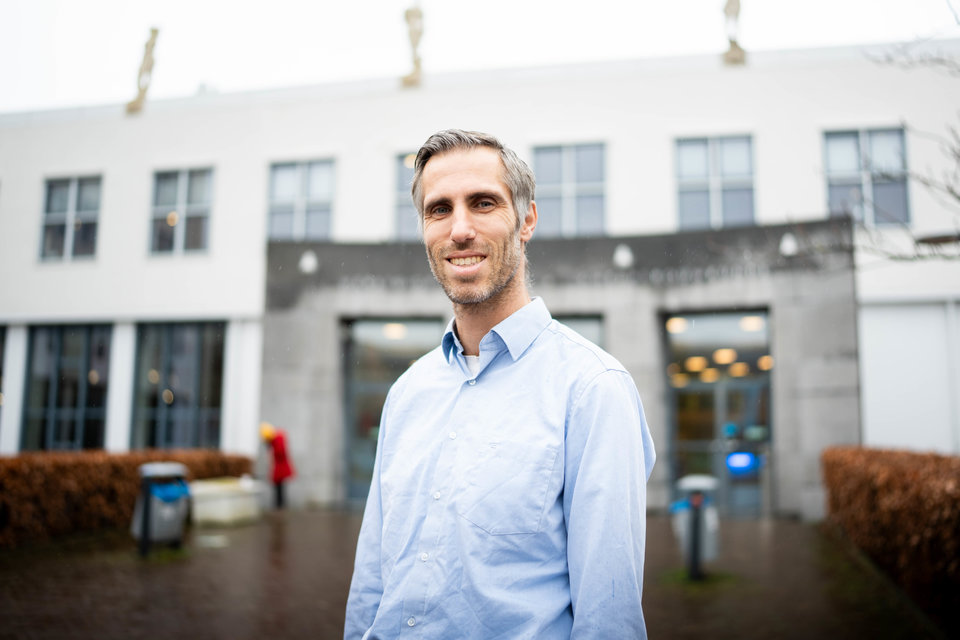Researcher Gerard Verbiest works on new chip technology using sound. Together with researchers at ASML, he investigates, among other things, how to apply sound to look inside a chip. It works, simply put, like medical ultrasound you can use to make an ultrasound of an unborn baby. "But we are looking at structures much smaller than a baby; the diameter of a head hair is 20 micrometres, and the nanostructures in a chip are a thousand times smaller than a hair."
Machines and machine parts are the Netherlands' most lucrative export product, with chip machine manufacturer ASML making the major contribution, according to government statistics from 2023. For the future of the computer chip, the company that builds machines that make computer chips sometimes looks at research at an early stage. Associate Professor Gerard Verbiest does chip research with sound waves, in collaboration with ASML.
He explains why this is important: "ASML makes machines that 'print' chips, and those chips consist of different layers on top of each other. You want to be able to check that there are no mistakes in them. If the layers are not exactly on top of each other, the chip won't work." So far, that checking for errors has been done with optical techniques. But because chips are getting smaller and smaller, this no longer works. Verbiest: "Sound might offer a solution for this. Moreover, with light you cannot see through opaque materials - a type of material increasingly used in chips - and with sound you can." Together with his PhD student Ruben Guis, Gerard Verbiest is investigating this promising new technique in his lab at the TU Delft faculty of Mechanical Engineering (ME). "I think sound can offer a solution to an urgent problem the chip industry is currently facing: the limits of optical technology. They cannot get much further with current techniques and cannot print much smaller."
The hardest thing to do
That this scientist ended up doing microchip research with sound actually makes complete sense when you hear about his own background: "My mother taught flute, we were always listening and playing music at home. And my father was a biochemist." Verbiest himself went on to study physics. "My father always said: physics is the hardest thing you can do. Well, that's when I started doing it. Whether I found it difficult? Haha, no, not really."
He graduated in theoretical physics and string theory in Leiden. "What I found unfortunate about that branch of physics is that it has nothing at all to do with practical things here on earth, you can't test or make anything. Instead, I wanted to invent something, and really contribute to relevant problems." He decided to switch to experimental physics so he could experiment in the lab. "I loved that. By the way, my first project was immediately about creating and using sound on a nanoscale, nano-acoustics. I actually never left that subject ever since."

Less energy consumption
What he likes best about his work is the constant challenge. "We can make or solve something that has not been understood until now. I always want to know how something works. Regularly, experiments fail. You think you understand something, and then it turns out to be wrong. Or the outcome of an experiment is very different from what you expect. But that is precisely the puzzle I want to solve. All those small steps together are crucial in getting the understanding, of an invention. At some point, everything works."
But what also appeals to him is that this research will find application: "We are solving a real problem. The goal, of course, is that ASML will one day actually be able to apply this technique." ”
Whether we will get a better world because of his research, he won't say. "We do hopefully get better electronics because of my research. And whether this makes the world better or notdepends on what people subsequently do with those electronics. It might. If you make better chips, you can, for example, develop electronics that use less energy."
Unique in the world
As a scientist, he also prefers not to deal with the geopolitical issues surrounding chips. "We focus on what we don't understand, what we like, what we want to find out. How that can be used, or abused, I'm not very concerned with that. I think that's more a job for politics. What I think of the EU Chips Act? The plan to build our own chip industry within Europe offers opportunities to universities. There is a great role ahead to go one step further than what we are already doing. If we do good research, we can stay ahead of competitors." The biggest competitors in his field are in the Netherlands itself and the United States. "There, too, they are looking at whether they can use sound waves to make things more visible at the nano-scale. But the research is different. The concept I am trying to work out here is so far unique in the world."
Why it is important to do this research together with researchers from ASML is because Verbiest gets valuable additions from the company, how the technology could possibly be implemented in practice, for example. "And whether it would be interesting to patent the ideas we have," he says. And as to why he wants to do this in Delft, he does not have to think long: "We have great facilities here, and I feel completely at home. I have a great research group. And I have the freedom here to find out what I like to find out - I wouldn't have that if I were employed by a company. And, perhaps most importantly, I really enjoy teaching." Verbiest teaches physics and linear dynamics to Mechanical Engineering students in the ME faculty, and coordinates undergraduate final projects in the Precision and Microsystems Engineering department.
When asked if he makes it to eighty hours of work per week doing all this, he has to laugh again. "No idea, I don't keep track, could be." Yet he also has time to play football, three times a week, and to play with his children and get out into nature. When he talks about his children, his eyes light up. My eight-year-old son already asks me things like: 'how can I calculate an area?' Or: 'What is time anyway?' Explain that!"
Organs filled with water
Finally, what do you say on a birthday when the neighbour asks what you do? "I also listen to plants, which is a bit easier to explain. Yes really, plants. They have a structure inside just like a microchip. If you send a sound wave into it, you can hear exactly how the plant feels. Plants are basically organs filled with water. You can hear if the plant is thirsty, needs more or less water. Verbiest developed a sound sensor called Plus-Plant, in full the Plantenna Ultrasound Monitoring system. "You can tell from a plant that it is not getting enough water, but if you wait until you see that on the outside, you are actually too late," he explained in an earlier interview with the Dutch newspaper FD.
What that sounds like, we humans cannot hear, because it is just over 20 kilohertz. That's kind of the same frequency that bats and many insects listen to." Plantenna is the research programme of TU Delft, Wageningen Research and University, Twente University and Eindhoven University together. It’s not only revolutionary, but a real conversation starter at parties. Verbiest: "Why did I start doing that research? People knew that plants make sound, but nobody knew what that sound meant. So I thought: that's what I want to know. The idea is that we can use this in the future to optimise water management in greenhouses and also detect diseases at an early stage."


